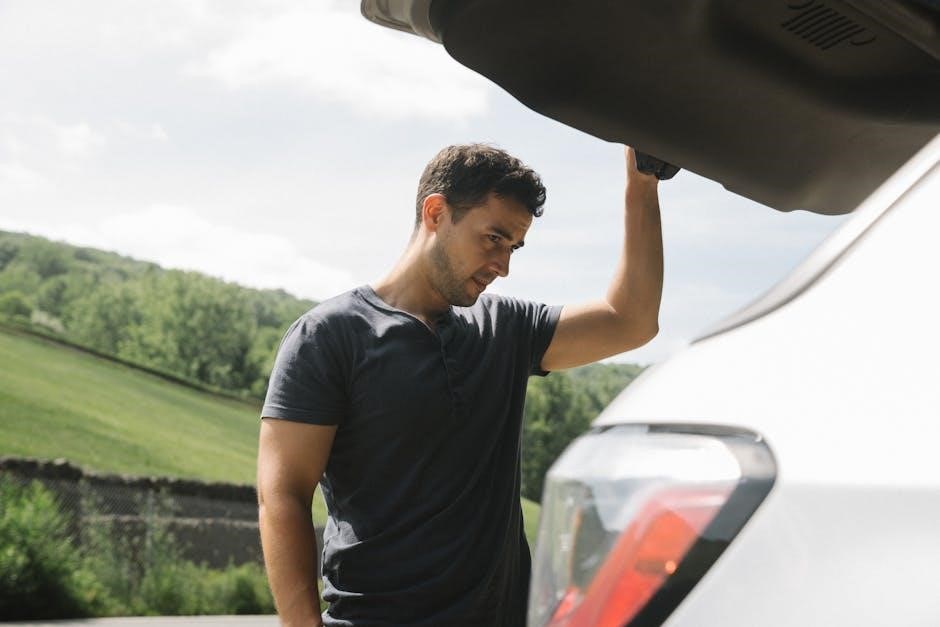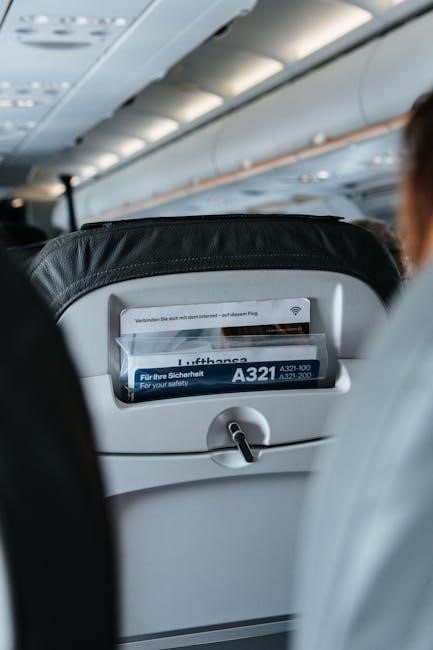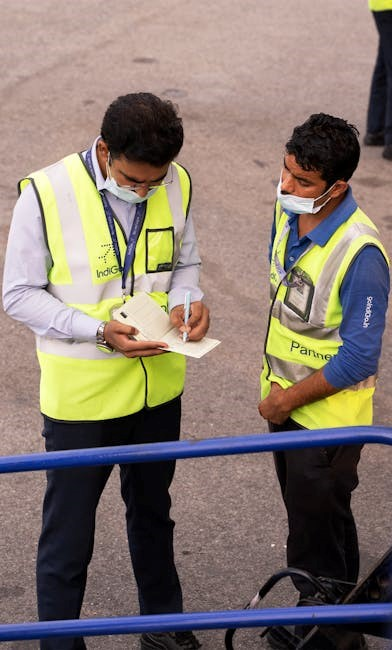A Class B pre-trip inspection ensures the vehicle is roadworthy, covering essential checks for safety, legal compliance, and optimal performance. It is a critical process for drivers to identify potential issues before operation.

What is a Class B Vehicle?
A Class B vehicle is a heavy-duty commercial vehicle with a gross vehicle weight rating (GVWR) of over 10,001 pounds. It includes straight trucks, buses, and motorhomes designed to transport goods or passengers. These vehicles require a Class B Commercial Driver’s License (CDL) to operate. Unlike Class A vehicles, Class B trucks do not pull trailers but may tow small attachments. Examples include city transit buses, garbage trucks, and large delivery trucks. The classification is crucial for licensing, insurance, and safety regulations. A pre-trip inspection checklist for Class B vehicles ensures adherence to safety standards, covering brakes, tires, lights, and fluid levels. This process helps prevent mechanical failures and ensures compliance with federal and state transportation laws. Regular inspections are vital for maintaining road safety and prolonging vehicle lifespan.
Importance of Pre-Trip Inspections
Pre-trip inspections are critical for ensuring the safety and reliability of Class B vehicles. They help identify potential mechanical issues before they lead to breakdowns or accidents. Regular checks ensure compliance with legal requirements, reducing the risk of fines or penalties. By addressing problems early, inspections prevent costly repairs and downtime. They also promote a culture of safety, protecting drivers, passengers, and other road users. Additionally, pre-trip inspections contribute to better fuel efficiency and vehicle performance, reducing long-term maintenance costs. Conducting thorough inspections is essential for maintaining public trust and operational integrity in the transportation industry. It is a proactive approach to minimizing risks and ensuring smooth, incident-free operations.

Class B Pre-Trip Inspection Checklist

A Class B pre-trip inspection checklist ensures a systematic review of vehicle components, including tires, brakes, lights, and fluids, to guarantee safety and regulatory compliance before operation.
Exterior Checks
Exterior checks involve inspecting the vehicle’s outer components to ensure safety and compliance. Start with the tires, checking for proper tread depth (at least 2/32”), even wear, and no signs of cuts, bubbles, or punctures. Verify tire pressure using a gauge and ensure the valve caps are secure. Next, examine the brakes, looking for wear or damage to pads, rotors, and brake lines. Inspect the lights, including headlights, taillights, brake lights, and turn signals, ensuring they function correctly and are free of cracks or dirt. Check the mirrors for proper adjustment and clarity. Finally, inspect the vehicle’s body for dents, leaks, or damage that could affect safety or performance. These exterior checks are critical for identifying potential issues before hitting the road.

Interior Checks
Interior checks focus on the cab and driver compartment, ensuring all systems are functional and safe. Begin by testing the brakes, including the parking brake and trailer brake, to ensure proper operation. Check the steering wheel for play or damage and verify that all gauges, such as the speedometer and oil pressure, are working correctly. Inspect the seat belts for condition and functionality. Test the horn and all interior lights to ensure they are operational. Check the air or hydraulic brake systems for leaks or damage. Finally, review the dashboard warning lights to ensure no issues are present before starting the engine. These interior checks are vital for maintaining control and safety while driving.
Engine Start and Brake Check
Start the engine and listen for unusual noises or vibrations. Check the dashboard warning lights to ensure no issues are present. Test the parking brake to confirm it holds the vehicle securely. For air or hydraulic brakes, perform a leak test by applying and releasing the brake pedal to check for any air leaks or pressure drops. Ensure the service brakes function properly by slowly pressing the brake pedal and feeling for a firm resistance. Verify that the brake system engages and disengages smoothly without any delays. These checks are crucial to ensure the vehicle can stop safely and maintain control during operation. Any issues detected during this process should be addressed before driving.
Under the Hood Inspection
Inspecting under the hood is a critical part of the Class B pre-trip inspection. Start by checking the engine oil and coolant levels to ensure they are within the recommended range. Look for any signs of leaks around the hoses, belts, and connections. Inspect the air filter for cleanliness and proper installation. Verify that all battery terminals are secure and free of corrosion. Check the power steering and brake fluid levels, and ensure the windshield washer reservoir is filled. Examine the serpentine belt for cracks or wear, and confirm that all hoses are flexible and not damaged. These checks help prevent mechanical failures and ensure the vehicle operates safely and efficiently. Always refer to the manufacturer’s guidelines for specific inspection criteria.

Conducting the Inspection
Conducting a Class B pre-trip inspection requires a systematic approach, ensuring all components are checked methodically. Use a checklist to verify brakes, tires, lights, and fluid levels. This ensures safety and compliance, helping to identify potential issues before they cause problems. A thorough inspection saves time and reduces risks during operation. Always follow the manufacturer’s guidelines and regulatory standards for accurate and efficient inspections.
Step-by-Step Process
The Class B pre-trip inspection follows a structured sequence. Begin with exterior checks, examining tires for wear and damage, ensuring proper tread depth and pressure. Inspect lights, brakes, and suspension for functionality and safety. Move to the interior, checking controls, mirrors, and seat belts. Start the engine to test brakes, hydraulics, and air systems. Open the hood to inspect fluids, belts, and hoses for leaks or wear. Finally, review all findings to ensure compliance and safety. This systematic approach ensures no critical components are overlooked, promoting safe and efficient vehicle operation. Consistency is key to identifying potential issues early, preventing breakdowns and ensuring legal compliance. Regular practice enhances familiarity with the process, making inspections quicker and more effective over time. Always refer to the Class B pre-trip inspection checklist PDF for detailed guidance and to stay updated with regulatory requirements. This comprehensive method guarantees thoroughness and adherence to industry standards, safeguarding both the driver and other road users. By following each step diligently, you can maintain vehicle reliability and minimize risks associated with improper inspections.
Using a Checklist Effectively
A Class B pre-trip inspection checklist is an essential tool for ensuring thoroughness and compliance. It provides a structured format to systematically evaluate all critical vehicle components. By following the checklist, drivers can avoid overlooking vital safety checks, such as brakes, lights, tires, and fluid levels. The checklist also serves as a legal document, demonstrating adherence to regulatory requirements. To use it effectively, review the checklist beforehand to familiarize yourself with its content. During the inspection, mark off items as you complete them and note any defects or issues. This method ensures accountability and helps identify potential problems early. Regularly updating the checklist and tailoring it to your vehicle’s specific needs can further enhance its effectiveness. Proper use of a checklist not only improves safety but also streamlines the inspection process, saving time and reducing the risk of oversights. Consistency is key to maximizing its benefits and ensuring reliable vehicle operation.
Understanding Inspection Criteria

Understanding the inspection criteria for a Class B pre-trip inspection is crucial for ensuring compliance and safety. The criteria are established by regulatory bodies and include specific standards for vehicle components such as brakes, tires, lights, and suspension systems. Drivers must verify that all parts are in good working condition, free from damage or wear. For example, tire tread depth must meet minimum requirements, and all lights must function properly. Fluid levels, such as coolant and oil, should be within recommended ranges. Additionally, the vehicle must be properly secured, with no leaks or structural issues. Familiarizing yourself with these criteria ensures that the inspection is thorough and that the vehicle meets legal and safety standards. Adhering to these guidelines helps prevent breakdowns and reduces the risk of accidents, making the inspection process both effective and necessary for safe operation.

Importance of the Pre-Trip Inspection
A pre-trip inspection ensures safety, compliance, and reduces maintenance costs by identifying issues early. It helps prevent accidents and ensures the vehicle is roadworthy for operation.

Safety Benefits
The pre-trip inspection significantly enhances safety by identifying potential hazards before they lead to accidents. By checking critical components like brakes, tires, and lights, drivers ensure the vehicle operates safely. Early detection of issues prevents breakdowns on the road, reducing the risk of collisions. A thorough inspection also verifies that all safety features are functional, such as mirrors, signals, and emergency brakes. This process not only protects the driver but also other road users, fostering a safer driving environment. Regular inspections contribute to a proactive approach to safety, minimizing risks associated with mechanical failures. Ultimately, a well-executed pre-trip inspection is a cornerstone of responsible and safe vehicle operation.
Legal Compliance
Conducting a Class B pre-trip inspection ensures adherence to federal and state regulations, avoiding potential legal penalties. Regular inspections demonstrate compliance with safety standards, reducing the risk of citations. By following the checklist, drivers meet the requirements for vehicle maintenance and operation, ensuring their vehicle is legally fit for the road. Non-compliance can result in fines, license suspension, or even legal action. Thus, a thorough pre-trip inspection is essential for maintaining legal standing and avoiding costly consequences. It also supports a culture of accountability and professionalism among drivers, ensuring they operate within the bounds of the law.
Reducing Maintenance Costs
A Class B pre-trip inspection helps identify and address minor issues before they escalate into costly repairs. By regularly checking components like tires, brakes, and fluids, drivers can prevent premature wear and tear. Early detection of problems such as leaks, worn parts, or improper alignments can save significant money on maintenance. Additionally, a well-maintained vehicle experiences less mechanical stress, extending its service life. This proactive approach not only reduces unexpected repair expenses but also minimizes downtime, ensuring the vehicle remains operational and efficient. Over time, consistent inspections lead to long-term financial savings for both individual drivers and fleet owners.

Resources and Tools
Utilize digital checklists, training manuals, and official guides like the Commercial Drivers License Manual for comprehensive pre-trip inspection preparation and compliance with Class B vehicle requirements.
Digital Checklists
Digital checklists offer a convenient and efficient way to perform Class B pre-trip inspections. Available as mobile apps or downloadable PDFs, these tools provide step-by-step guidance, ensuring no critical components are overlooked. They often include features like checkmarks, notes, and real-time updates, making it easier to track inspections. Many apps, such as those designed for CDL training, allow drivers to review and verify each item systematically. Digital checklists also reduce the risk of human error and ensure compliance with safety standards. By using these tools, drivers can streamline the inspection process, saving time while maintaining thoroughness. They are particularly useful for new drivers learning the ropes or for experienced operators seeking to enhance their pre-trip routines. Overall, digital checklists are a modern, reliable solution for ensuring vehicle safety and regulatory compliance.
Training Materials
Training materials for Class B pre-trip inspections are widely available, offering comprehensive guidance for drivers. These resources include detailed checklists, instructional videos, and step-by-step manuals. Many materials are designed for CDL training programs, helping students master the inspection process. They cover exterior, interior, and under-the-hood checks, as well as brake and engine start procedures. Interactive tools, such as mobile apps, allow drivers to practice inspections virtually. Training materials also emphasize safety protocols and legal requirements, ensuring drivers understand their responsibilities. By leveraging these resources, drivers can improve their knowledge and confidence, preparing them for successful pre-trip inspections and compliant vehicle operation.
